Nationality American Role Aviator Name Wally Schirra | Status Deceased | |
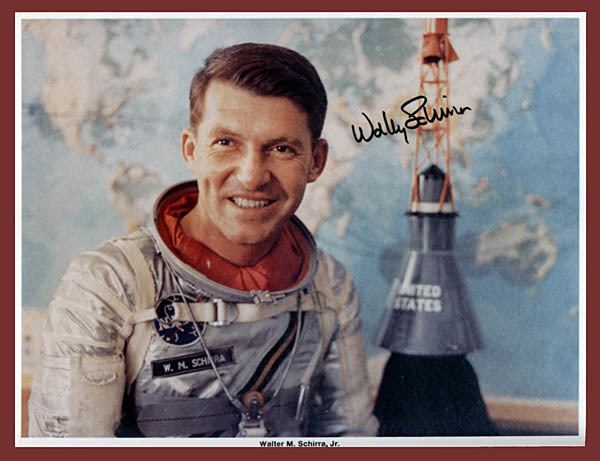 | ||
Other names Walter Marty Schirra, Jr. Alma mater Newark College of EngineeringUSNA, B.S. 1945 Spouse Josephine Fraser (m. 1946–2007) Children Walter Marty Schirra III, Suzanne Schirra Education New Jersey Institute of Technology (1941), Dwight Morrow High School, United States Naval Academy Similar People | ||
Wally Schirra interview Gemini & Apollo
Walter Marty "Wally" Schirra Jr. (March 12, 1923 – May 3, 2007), (CAPT, USN), was an American naval officer and aviator, aeronautical engineer, test pilot, and one of the original seven astronauts chosen for Project Mercury, United States first effort to put humans in space. He flew the six-orbit, nine-hour Mercury-Atlas 8 mission on October 3, 1962, becoming the fifth American, and the ninth human, to ride a rocket into space. In the two-man Gemini program, he achieved the first space rendezvous, station-keeping his Gemini 6A spacecraft within 1 foot (30 cm) of the sister Gemini 7 spacecraft in December 1965. In October 1968, he commanded Apollo 7, an 11-day low Earth orbit shakedown test of the three-man Apollo Command/Service Module. He was the first person to go into space three times, and the only person to have flown in Mercury, Gemini, and Apollo, logging a total of 295 hours and 15 minutes in space. He retired from the U.S. Navy at the rank of Captain and from NASA after his Apollo flight, becoming a consultant to CBS News for its coverage of the subsequent Apollo flights. He joined Walter Cronkite as co-anchor for the seven Moon landing missions.
Contents
- Wally Schirra interview Gemini Apollo
- WALLY SCHIRRAS LAUNCHPAD DECISION
- Early life and education
- Navy service
- Mercury Seven
- Project Gemini
- Apollo program
- Television career
- Business career
- Writing career
- Death
- Organizations
- Awards and legacy
- Honorary academic degrees
- Hall of fame inductions
- Legacy
- In media
- References

Schirra died at the age of 84 on May 3, 2007 of a heart attack while undergoing treatment for abdominal cancer.
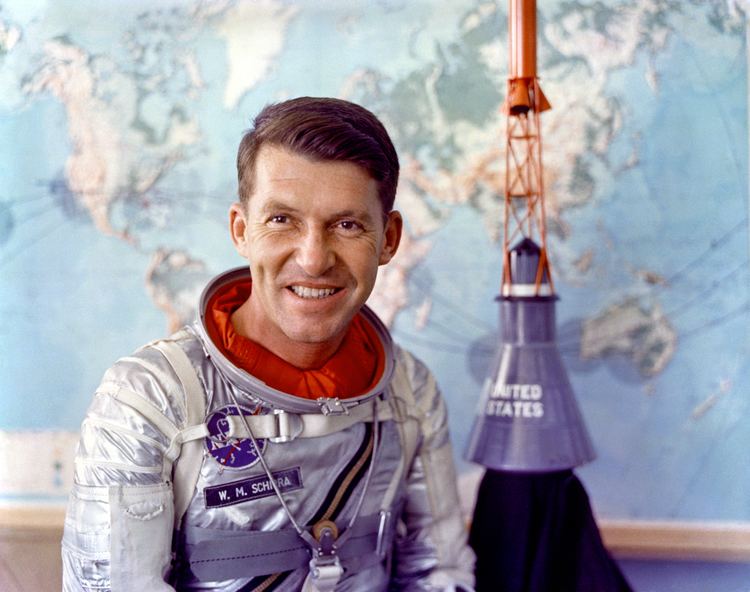
WALLY SCHIRRA'S LAUNCHPAD DECISION
Early life and education
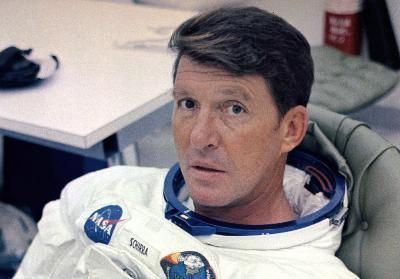
Schirra was born on March 12, 1923 in Hackensack, New Jersey, to an aviation family. His paternal grandparents were from Bavaria and Switzerland, and were originally from Ghilarza in Sardinia. Schirra's father, Walter M. Schirra Sr., who was born in Philadelphia, joined the Royal Canadian Air Force during World War I, and flew bombing and reconnaissance missions over Germany. After the war he barnstormed at county fairs around New Jersey. Schirra's mother, Florence Shillito (née Leach) Schirra, went along on her husband's barnstorming tours and performed wing walking stunts. By the time he was 15, Wally was flying his father's airplane. His hobbies were skiing, hunting, sailing, and fishing.
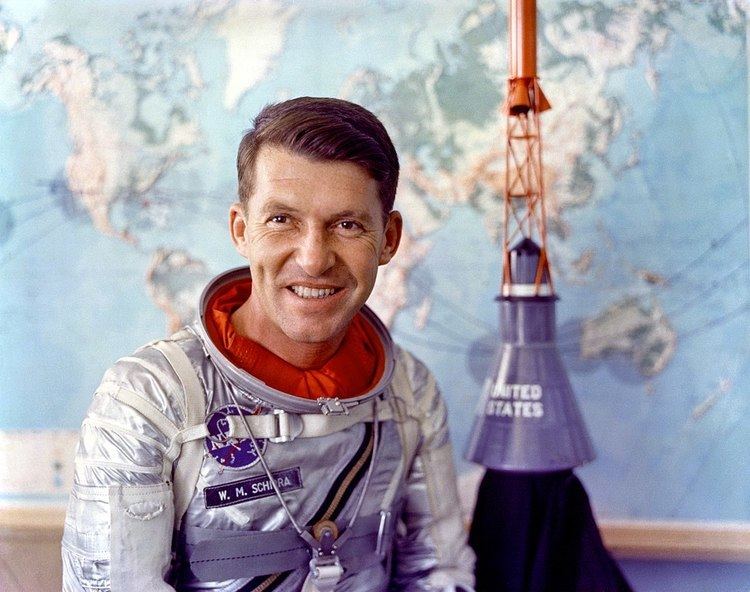
Schirra was a Boy Scout and earned the rank of First Class in Troop 36 in Oradell, New Jersey.
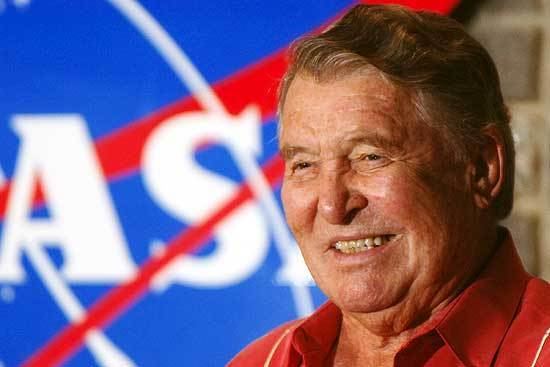
Schirra attended elementary school in Oradell, graduating in 1936, and graduated from Dwight Morrow High School in Englewood, New Jersey in 1940. He attended the Newark College of Engineering, where he was a member of Sigma Pi fraternity, Alpha Mu chapter. He was later appointed to the United States Naval Academy, and graduated with the accelerated Class of 1946 with a Bachelor of Science degree in 1945.

He married the former Josephine Cook "Jo" Fraser of Seattle, Washington on February 23, 1946; she was the step-daughter of Admiral James L. Holloway Jr.. They had two children: Walter M. Schirra, III, born June 23, 1950 and Suzanne, born September 29, 1957. Jo Schirra died April 27, 2015.
Navy service
He attended the United States Naval Academy from 1942 until graduation in 1945 when he was commissioned as an ensign in the United States Navy on June 6, 1945. Schirra served during the final months of World War II aboard the large cruiser USS Alaska. After the war ended, he trained as a Naval Aviator at Naval Air Station Pensacola, Florida, received his wings in 1948 and joined Fighter Squadron 71 (VF-71). He was the second Navy pilot to log 1,000 hours in jet aircraft.
Upon the outbreak of the Korean War, Schirra was dispatched to South Korea as an exchange pilot on loan to the U.S. Air Force. He served as a flight leader with the 136th Fighter Bomber Wing, and then as operations officer with the 154th Fighter-Bomber Squadron. He flew 90 combat missions between 1951 and 1952, mostly in F-84 Thunderjet. Schirra was credited with downing one MiG-15 and damaging two others. Schirra received the Distinguished Flying Cross and the Air Medal with an oak leaf cluster for his service in Korea.
After his tour in Korea, Schirra served as a test pilot. In 1957 he attended the Naval Air Safety Officer School at the University of Southern California and he attended the U.S. Naval Test Pilot School at Naval Air Station Patuxent River, Maryland, graduating in 1958. At Naval Ordnance Test Station China Lake, California (NOTS), he tested weapons systems such as the Sidewinder missile and the F7U-3 Cutlass jet fighter. During one flight, Schirra fired a Sidewinder missile and the missile "doubled back" and started to chase his jet. Schirra, through skillful flying, avoided the Sidewinder.
After spending time as a flight instructor and carrier based aviator, he later returned to his test pilot duties and helped evaluate the F-4 Phantom II jet fighter for Naval service.
Mercury Seven
In 1959, Schirra was one of 110 military test pilots selected by their commanding officers as candidates for the newly formed National Aeronautics and Space Administration's Project Mercury, the first U.S. manned space flight program. Following a gruelling series of physical and psychological tests, on April 2, 1959, Schirra was chosen as one of the original seven American astronauts. Schirra's special responsibility in Project Mercury was the development of environmental controls or life-support systems that would ensure the safety and comfort of the astronaut within the spacecraft during the mission. His tasks also included the testing and improvement of the pressurized suit worn by the astronauts.
On October 3, 1962, Schirra became the fifth American in space, piloting the Mercury-Atlas 8 (Sigma 7) on a six-orbit mission lasting 9 hours, 13 minutes, and 11 seconds. The capsule attained a velocity of 17,557 miles per hour (28,255 km/h) and an altitude of 175 statute miles (282 km), and landed within 4 miles (6.4 km) of the main Pacific Ocean recovery ship. On October 16, 1962, Schirra and his family were greeted by President Kennedy at the White House, just hours after Kennedy received information leading to the Cuban Missile Crisis.
Project Gemini
On December 15, 1965, Schirra flew into space a second time as Command Pilot of Gemini 6A, with Pilot Tom Stafford. Gemini 6, originally scheduled to launch on October 25, was planned to perform the first space rendezvous and docking with an unmanned Agena target vehicle launched separately, but the Agena was destroyed in a launch failure. It was decided to defer launch of the alternate mission 6A to after the December launch of Gemini 7, during which Schirra would perform rendezvous, but without docking. During the first rescheduled launch attempt, the booster rocket unexpectedly shut down seconds after ignition and did not launch. Although mission rules called for the crew to eject from the spacecraft in that situation, Schirra used his pilot's judgement and did not eject, as he had not detected any upwards motion. This turned out to be the correct call for their personal safety. The flight was launched successfully three days later, and Schirra successfully performed the first rendezvous with Gemini 7 containing astronauts Frank Borman and James Lovell, station-keeping his craft to distances as close as 1 foot (30 cm). Gemini 6 landed in the Atlantic Ocean the next day, while Gemini 7 continued on to set a 14-day manned space record.
While on the Gemini mission, Schirra played a Christmas practical joke on the flight controllers by first reporting a mock UFO (implying Santa Claus) sighting, then playing "Jingle Bells" on a four-hole Hohner harmonica he had smuggled on board, accompanied by Stafford on sleigh bells. Hohner subsequently produced a "Wally Schirra" commemorative model.
Apollo program
In late 1966, Schirra was assigned to command a three-man Apollo crew with Donn F. Eisele and R. Walter Cunningham to make the second manned flight test of the Apollo Command/Service Module some time in 1967, after the first such flight to be made by Gus Grissom, Edward White and Roger Chaffee. But soon after, this second test flight was considered unnecessary, and Schirra's crew was reassigned as Grissom's backup. But in January 1967, Grissom and his crew were killed in a cabin fire during a ground test of Apollo 1. Schirra's crew was thereby promoted to prime crew of the first manned flight. This became Apollo 7 in the program's revised mission numbering plan, and was delayed to the fall of 1968 while safety improvements were made to the Command Module.
Schirra, like most of the Mercury and Gemini astronauts, had come to gain a sense of security from the Pad Leader responsible for the spacecraft's launch readiness, an extremely diligent, uncompromising McDonnell Aircraft employee, Guenter Wendt. But since the Apollo contractor was North American Aviation, Wendt was no longer pad leader. After the Apollo 1 accident, Schirra felt so strongly he wanted none other than Wendt as pad leader for his Apollo flight, that he pulled strings with his boss Deke Slayton and North American's launch operations manager Bastian "Buzz" Hello to hire Wendt so he could be Apollo 7 pad leader. Wendt remained pad leader for the remainder of the Apollo and Skylab programs, and stayed on with NASA into the Space Shuttle program before retiring.
Apollo 7 was launched on October 11, 1968, making Schirra the first person to fly in space three times. Schirra, Eisele and Cunningham spent eleven days in Earth orbit, performed space rendezvous exercises with the upper stage of the Saturn 1-B launch vehicle that sent them into space, and provided the first live television pictures publicly broadcast from inside a manned spacecraft, for which Schirra received an Emmy Award. (An experimental TV transmission had been made during Gordon Cooper's Mercury flight in 1963, but this was not broadcast to the public.)
During the mission, Schirra caught what would become perhaps the most famous head cold in NASA history. He soon passed the cold to Eisele, and the crew became known for their grumpy exchanges with Mission Control. Schirra had made the decision before launch to retire after this flight, and left the NASA Astronaut Corps on July 1, 1969.
Schirra's logbooks show a total of 4,577 hours flight time (including 295 in space) and 267 carrier landings.
In 2008, NASA posthumously awarded Schirra the NASA Distinguished Service Medal for his Apollo 7 mission.
Television career
A combination of pseudoephedrine decongestant with triprolidine antihistamine was the cold medicine carried on board the Apollo missions and prescribed by the flight surgeon. Years later when this became available over the counter as Actifed, the makers of Actifed hired Schirra as a television commercial spokesman, based on the notoriety of his Apollo 7 in-space head cold.
During later Apollo missions, he served as a consultant to CBS News, joining Walter Cronkite to co-anchor the network's coverage of the seven Moon landing missions, starting with Apollo 11 (joined by Arthur C. Clarke), including the ill-fated Apollo 13.
Business career
Following his NASA career, Schirra become a President of Regency Investors Incorporated, a major financial complex and worldwide leasing company based in Denver, Colorado. From 1970 to 1973, he was Chairman and Chief Executive Officer of Environmental Control Company (ECCO), based in Englewood, Colorado. From 1973 to 1974, he was Chairman of the board of SERNCO Incorporated, and for the next three years he was a Director at Johns-Manville Corporation in Denver, Colorado. From 1978 to 1979, he was Vice President for development at Goodwin Companies Incorporated in Littleton, Colorado.
In January 1979, Schirra formed his own firm, Schirra Enterprises, and he worked as a consultant in 1979 and 1980. In 1980, he was elected to the Board of Directors of Electromedics Incorporated. He has also served as President of Prometheus, an energy development company in Colorado, and on the Board of Directors of Kimberly-Clark, Finalco and Net Air International. In 1984, he and the other surviving Mercury astronauts and Gus Grissom's widow, Betty Grissom, founded the Mercury Seven Foundation to raise money for scholarships for science and engineering students in college. In 1995, the organization was renamed the Astronaut Scholarship Foundation.
Writing career
In 1988 (republished in 1999) Wally Schirra, with Richard N. Billings, released his first autobiography Schirra's Space.
In 1995 Schirra co-authored the book Wildcats to Tomcats: The Tailhook Navy with fellow Navy Captains Richard L. (Zeke) Cormier, and Phil Wood, with Barrett Tillman as the writer. It has a section by each of these Naval Aviators that cover five decades of flight experiences, including combat tours in World War II, Korea & Vietnam.
In 2005 Schirra co-authored the book The Real Space Cowboys with Ed Buckbee. The book is an account of the 'Mercury Seven' astronauts. It follows them through the process of selection for the program, their entire careers, and into retirement. Wernher von Braun, NASA, Space Camp, and the U.S. Space and Rocket Center are given special attention.
Schirra was also a major contributor to the 2007 book, In the Shadow of the Moon, which captured his final published thoughts on his life and career.
Death
Schirra died on May 3, 2007 of a heart attack while undergoing treatment for abdominal cancer at Scripps Green Hospital (currently The Heart Center at Scripps) in La Jolla, California. He was 84 years old. A memorial service for Schirra was held on May 22 at Fort Rosecrans National Cemetery in California. The ceremony concluded with a three-volley salute and a flyover by three F/A-18s. Schirra was cremated and his ashes were committed to the sea on February 11, 2008. The burial at sea ceremony was held aboard the Nimitz-class aircraft carrier USS Ronald Reagan and his ashes were released by Commander Lee Axtell, CHC, USN, the command chaplain aboard.
His widow, Josephine “Jo” Schirra, died on April 27, 2015, in Rancho Santa Fe, California at the age of 91.
Organizations
He was a fellow in the American Astronautical Society and the Society of Experimental Test Pilots; a member of the American Institute of Aeronautics and Astronautics and American Fighter Pilots Association; a 33rd Degree Mason; director of the Rocky Mountain Airways; on the Department of the Interior Advisory Board on National Parks, Historical Sites and Monuments; a member of the Honorary Belgian Consul of Colorado; and Director of Electromedics, Colorado, and Watt County, Nashville, Tennessee.
Awards and legacy
US government awards:
International awards:
Non-government awards:
Honorary academic degrees
Honorary Doctorate of Astronautical Engineering from Lafayette College; Honorary Doctorate of Astronautics from the Newark College of Engineering; and an Honorary D.Sc. from the University of Southern California.
Hall of fame inductions
Schirra was inducted into the International Space Hall of Fame in 1981.
Schirra was enshrined in the National Aviation Hall of Fame in 1986.
Schirra was inducted into the U.S. Astronaut Hall of Fame on May 11, 1990.
In 2010 Schirra was inducted into the New Jersey Hall of Fame.
Legacy
USNS Wally Schirra (T-AKE-8), a Lewis and Clark-class dry cargo ship named for Schirra, was christened and launched March 8, 2009.
A street and a small park are named after Schirra in Oradell, New Jersey and Upper Dublin, Pennsylvania.
An elementary school in Old Bridge Township, New Jersey, is named after Schirra.
In media
Wally Schirra was portrayed by Lance Henriksen in the film The Right Stuff, by Mark Harmon in the 1998 HBO miniseries From the Earth to the Moon, and by Aaron McCusker in the 2015 ABC-TV series The Astronaut Wives Club.
Schirra was mentioned in the second episode of WKRP in Cincinnati. The "Pilot Part 2" episode from 9/25/1978, featured the Station Manager, Arthur Carlson saying that his maid believed Wally Schirra was controlling her mind and she believed she had to store up foods.
In an episode of The Venture Bros, Wally is mentioned as having participated in a threesome with recurring fictional character Colonel Gentleman, and Gore Vidal. In a later episode, he is again referenced by Gentleman in a flashback, who expresses concern for his participation in a potentially sabotaged Apollo mission.
